You are using an out of date browser. It may not display this or other websites correctly.
You should upgrade or use an alternative browser.
You should upgrade or use an alternative browser.
Any idea on this vase
- Thread starter jtw1313
- Start date
- Joined
- Apr 24, 2010
- Messages
- 12,923
- Reaction score
- 27,656
- Golden Thread
- 1
- Location
- Upper Canada 🇨🇦
- 🥇 Banner finds
- 1
- 🏆 Honorable Mentions:
- 3
- Detector(s) used
- XP Deus, Lesche Piranha 35 Shovel & 'Garrett Carrot'
- Primary Interest:
- Relic Hunting
Your vase looks similar to Carnival Glass to me. 
"Carnival glass is moulded or pressed glass, always with a pattern and always with a shiny, metallic, 'iridescent' surface shimmer. The keys to its appeal were that it looked superficially like the much finer and much more expensive blown iridescent glass by Tiffany, Loetz and others and also that the cheerful bright finish caught the light even in dark corners of the home. Both functional and ornamental objects were produced in the carnival finish and patterns ranged from simple through geometric and 'cut' styles to pictorial and figurative. A wide range of colours and colour combinations were used but the most common colours accounted for a large proportion of output, so scarce colours can today command very high prices on the collector market.
Carnival glass originated as a glass called 'Iridill', produced beginning in 1908 by the Fenton Art Glass Company (founded in 1905). Iridill was inspired by the fine blown art glass of such makers as Tiffany and Steuben but did not sell at the anticipated premium prices and was subsequently discounted. After these markdowns, Iridill pieces were used as carnival prizes.
Iridill became popular and very profitable for Fenton, which produced many different types of items in this finish, in over 150 patterns. Fenton maintained their position as the largest manufacturer and were one of very few makers to use a red coloured glass base for their carnival glass. After interest waned in the late 1920s, Fenton stopped producing carnival glass for many years. In more recent years, due to a resurgence in interest, Fenton restarted production of carnival glass until its closure in 2007. Most U.S. carnival glass was made before 1925, with production in clear decline after 1931. Some significant production continued outside the US through the depression years of the early 1930s, tapering off to very little by the 1940s."
Dave
"Carnival glass is moulded or pressed glass, always with a pattern and always with a shiny, metallic, 'iridescent' surface shimmer. The keys to its appeal were that it looked superficially like the much finer and much more expensive blown iridescent glass by Tiffany, Loetz and others and also that the cheerful bright finish caught the light even in dark corners of the home. Both functional and ornamental objects were produced in the carnival finish and patterns ranged from simple through geometric and 'cut' styles to pictorial and figurative. A wide range of colours and colour combinations were used but the most common colours accounted for a large proportion of output, so scarce colours can today command very high prices on the collector market.
Carnival glass originated as a glass called 'Iridill', produced beginning in 1908 by the Fenton Art Glass Company (founded in 1905). Iridill was inspired by the fine blown art glass of such makers as Tiffany and Steuben but did not sell at the anticipated premium prices and was subsequently discounted. After these markdowns, Iridill pieces were used as carnival prizes.
Iridill became popular and very profitable for Fenton, which produced many different types of items in this finish, in over 150 patterns. Fenton maintained their position as the largest manufacturer and were one of very few makers to use a red coloured glass base for their carnival glass. After interest waned in the late 1920s, Fenton stopped producing carnival glass for many years. In more recent years, due to a resurgence in interest, Fenton restarted production of carnival glass until its closure in 2007. Most U.S. carnival glass was made before 1925, with production in clear decline after 1931. Some significant production continued outside the US through the depression years of the early 1930s, tapering off to very little by the 1940s."
Dave
Upvote
0
- Joined
- Dec 12, 2009
- Messages
- 2,817
- Reaction score
- 3,356
- Golden Thread
- 0
- Location
- St. Charles County, Missouri
- Detector(s) used
- Garrett AT Pro, Tesoro Vaquero, Bounty Hunter Land Star, Teknetics Delta 4000, Minelab Equinox 600, Garrett Carrot
- Primary Interest:
- All Treasure Hunting
So you already know what it is? Why post it?
Upvote
0
Tpmetal
Silver Member
- Joined
- Jan 4, 2017
- Messages
- 4,599
- Reaction score
- 7,960
- Golden Thread
- 0
- Location
- Western ny
- Detector(s) used
- equinox 800, Whites mx sport, Garrot carrot, bounty hunter time ranger
- Primary Interest:
- All Treasure Hunting
Your vase looks similar to Carnival Glass to me.
"Carnival glass is moulded or pressed glass, always with a pattern and always with a shiny, metallic, 'iridescent' surface shimmer. The keys to its appeal were that it looked superficially like the much finer and much more expensive blown iridescent glass by Tiffany, Loetz and others and also that the cheerful bright finish caught the light even in dark corners of the home. Both functional and ornamental objects were produced in the carnival finish and patterns ranged from simple through geometric and 'cut' styles to pictorial and figurative. A wide range of colours and colour combinations were used but the most common colours accounted for a large proportion of output, so scarce colours can today command very high prices on the collector market.
Carnival glass originated as a glass called 'Iridill', produced beginning in 1908 by the Fenton Art Glass Company (founded in 1905). Iridill was inspired by the fine blown art glass of such makers as Tiffany and Steuben but did not sell at the anticipated premium prices and was subsequently discounted. After these markdowns, Iridill pieces were used as carnival prizes.
Iridill became popular and very profitable for Fenton, which produced many different types of items in this finish, in over 150 patterns. Fenton maintained their position as the largest manufacturer and were one of very few makers to use a red coloured glass base for their carnival glass. After interest waned in the late 1920s, Fenton stopped producing carnival glass for many years. In more recent years, due to a resurgence in interest, Fenton restarted production of carnival glass until its closure in 2007. Most U.S. carnival glass was made before 1925, with production in clear decline after 1931. Some significant production continued outside the US through the depression years of the early 1930s, tapering off to very little by the 1940s."
Dave
This is hand blown for sure, not moulded. Its funny you mention fenton, at work we have barrels and barrels full of cullet from fenton thats mostly smashed up pieces that didn't make the cut.
How are those beads attached? does it look glued on cold? this could help date the piece.
Upvote
0
DCMatt
Gold Member
- Joined
- Oct 12, 2006
- Messages
- 10,472
- Reaction score
- 13,785
- Golden Thread
- 0
- Location
- Herndon Virginia
- Detector(s) used
- Minelab Equinox 600, EX II, & Musketeer, White's Classic
- Primary Interest:
- Metal Detecting
So you already know what it is? Why post it?
To confirm the ID while not leading the thread into "group think" exercise.
That's really my preference when I go to research an item. Don't lead me down a potentially wrong path with what you 'think' it might be.
Too often items posted here are not what the OP wants them to be. Let me do my own work based on the evidence presented.
That said, I don't think it is a Fritz Heckert piece. But then I'm not much of a glass guy, either...
Upvote
0
jtw1313
Silver Member
- Joined
- Feb 5, 2013
- Messages
- 3,724
- Reaction score
- 2,092
- Golden Thread
- 0
- Primary Interest:
- All Treasure Hunting
- #7
Thread Owner
Didn't know what it was till after I posted.......I really don't have time to go through why I think what it is.......I'm always on the move but thank you everyone for all your comments and help on everything it is always appreciated
Last edited:
Upvote
0
- Joined
- Apr 24, 2010
- Messages
- 12,923
- Reaction score
- 27,656
- Golden Thread
- 1
- Location
- Upper Canada 🇨🇦
- 🥇 Banner finds
- 1
- 🏆 Honorable Mentions:
- 3
- Detector(s) used
- XP Deus, Lesche Piranha 35 Shovel & 'Garrett Carrot'
- Primary Interest:
- Relic Hunting
Actually I think it is a coralene fritz heckert 1880s vase
I'm sorry, but don't see Fritz Heckert in your vase, although it is similar.
Here are some examples of Fritz Hecker pieces, note how he signs the base of his works.

Dave
Attachments
-
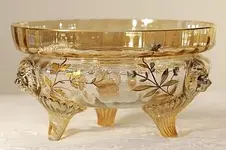 8296251261b1daa5a614c9830a9090a2.webp18.6 KB · Views: 61
8296251261b1daa5a614c9830a9090a2.webp18.6 KB · Views: 61 -
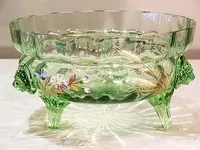 c0ec24e79d69694935afec626ac5f898.webp27.6 KB · Views: 66
c0ec24e79d69694935afec626ac5f898.webp27.6 KB · Views: 66 -
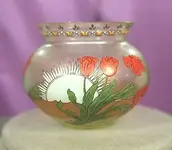 IMG0082-thumbnail-800x600-crop.webp15.3 KB · Views: 76
IMG0082-thumbnail-800x600-crop.webp15.3 KB · Views: 76 -
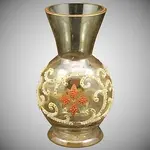 Fritz-Heckert-Art-Nouveau-Coralene-Mini-full-1-720 10.10-76-r-ffffff-5.webp15 KB · Views: 62
Fritz-Heckert-Art-Nouveau-Coralene-Mini-full-1-720 10.10-76-r-ffffff-5.webp15 KB · Views: 62 -
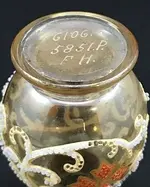 Fritz-Heckert-Art-Nouveau-Coralene-Mini-full-4-720-269-r-ffffff-5.webp20.6 KB · Views: 76
Fritz-Heckert-Art-Nouveau-Coralene-Mini-full-4-720-269-r-ffffff-5.webp20.6 KB · Views: 76
Upvote
0
jtw1313
Silver Member
- Joined
- Feb 5, 2013
- Messages
- 3,724
- Reaction score
- 2,092
- Golden Thread
- 0
- Primary Interest:
- All Treasure Hunting
- #9
Thread Owner
Coralene vases were made and signed "Patent" in 1884
I was told to look in the book of Stefania zelasko "fritz Heckert" page 128 fig: 172-174
So I guess I will have to find the book and see lol
I was told to look in the book of Stefania zelasko "fritz Heckert" page 128 fig: 172-174
So I guess I will have to find the book and see lol
Upvote
0
DizzyDigger
Gold Member
- Joined
- Dec 9, 2012
- Messages
- 6,894
- Reaction score
- 14,820
- Golden Thread
- 0
- Location
- Concrete, WA
- Detector(s) used
- Nokta FoRs Gold, a Gold Cube, 2 Keene Sluices and Lord only knows how many pans....not to mention a load of other gear my wife still doesn't know about!
- Primary Interest:
- Prospecting
JTW, here is your vase:
https://www.worthpoint.com/worthopedia/antique-bohemian-victorian-heckert-1900576613
"Victorian Coralene Art Glass Vase
Description:
Victorian era, art glass vase with applied feet is decorated with Coralene decoration.
The vase is blown of cranberry glass spreading to orange.
Applied base is three greenish-amber tree trunk style feet with pinched thorns
and pulled branches.
Hand painted decoration depicts a fruit tree branch with pears and leaves. There is
also an applied branch that wraps partially around the vase. Decoration is entirely
covered with Coralene (glass beads) through out.
Rim has a hand tooled crimp. The base has a polished pontil and is signed, W. Patent. L.
The first coralene patent was obtained by Arthur Schierholz of Plausen, Thuringia, in
the German Empire, on July 7, 1883. Fritz Heckert held a license to produced glasswares
with the Coralene decoration, and other Bohemian glasshouses such as Loetz followed.
There is a theory the W. Patent L. mark could be from British retailer, W. Lund who
commissioned a Bohemian glasshouse to produce these Coralene examples found with
this distinctive mark. "
https://www.worthpoint.com/worthopedia/antique-bohemian-victorian-heckert-1900576613
"Victorian Coralene Art Glass Vase
Description:
Victorian era, art glass vase with applied feet is decorated with Coralene decoration.
The vase is blown of cranberry glass spreading to orange.
Applied base is three greenish-amber tree trunk style feet with pinched thorns
and pulled branches.
Hand painted decoration depicts a fruit tree branch with pears and leaves. There is
also an applied branch that wraps partially around the vase. Decoration is entirely
covered with Coralene (glass beads) through out.
Rim has a hand tooled crimp. The base has a polished pontil and is signed, W. Patent. L.
The first coralene patent was obtained by Arthur Schierholz of Plausen, Thuringia, in
the German Empire, on July 7, 1883. Fritz Heckert held a license to produced glasswares
with the Coralene decoration, and other Bohemian glasshouses such as Loetz followed.
There is a theory the W. Patent L. mark could be from British retailer, W. Lund who
commissioned a Bohemian glasshouse to produce these Coralene examples found with
this distinctive mark. "
Upvote
0
DCMatt
Gold Member
- Joined
- Oct 12, 2006
- Messages
- 10,472
- Reaction score
- 13,785
- Golden Thread
- 0
- Location
- Herndon Virginia
- Detector(s) used
- Minelab Equinox 600, EX II, & Musketeer, White's Classic
- Primary Interest:
- Metal Detecting
Here's one. Heckert turn of the 20th C Water lily vase.
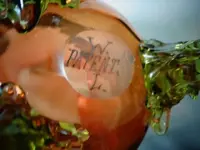
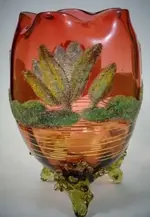
https://www.ebay.com/itm/Antique-Bo...vip=true&rt=nc&_trksid=p2047675.m43663.l44720


https://www.ebay.com/itm/Antique-Bo...vip=true&rt=nc&_trksid=p2047675.m43663.l44720
As an eBay Associate we earn from qualifying purchases.
Upvote
0
Similar threads
- Replies
- 0
- Views
- 354
- Replies
- 20
- Views
- 854
Users who are viewing this thread
Total: 1 (members: 0, guests: 1)



